Comets C/2001 Q4 (NEAT ) and C/2002 T7 (LINEAR).


Here are some CCD images of these very interesting comets, imaged by Gianluca Masi and Franco Mallia, as part of an educational project
To get these images, we used the SoTIE telescope in Las Campanas and we are particularly grateful to the NASA/TIE team, as well as to Software Bisque, for their support and disposability. Some of them have been posted on the Comet Observation Home Page (where you can find a lot of information about comets in general). Now, we make them available on this page, so you can see at a glance how their brightness increased and interesting structures appeared. They are in inverse chronological order.
This page will be updated once new images will be available. Those wishing to use them, are kindly asked to contact us. A mirror of this page is available on Campo Catino Observatory's website. Last update: 19 July 2004.
Choose your comet:
C/2001 Q4 (NEAT) - C/2002 T7 (LINEAR)
Comet C/2001 Q4 was discovered by the NEAT survey on 24 Aug. 2001. Since the beginning, it was clear that is was a potentially interesting object, with fair probabilities to become visible with the naked eye. In fact. it was visibile last May, even if not as bright as hoped.
C/2001 Q4 has been a southern object for months; for this, it received only a modest follow up (at least if compared to its "cousin" C/2002 T7, another promising comet - see below) so these images are particularly important and precious.
13 May 2004, around 00:30 UT. About 10 images have been median-combined to remove stars and then enhanced with a Prewitt filter to show dust shells. Clicking on the image an animation is available, showing the expansion of the dust waves.
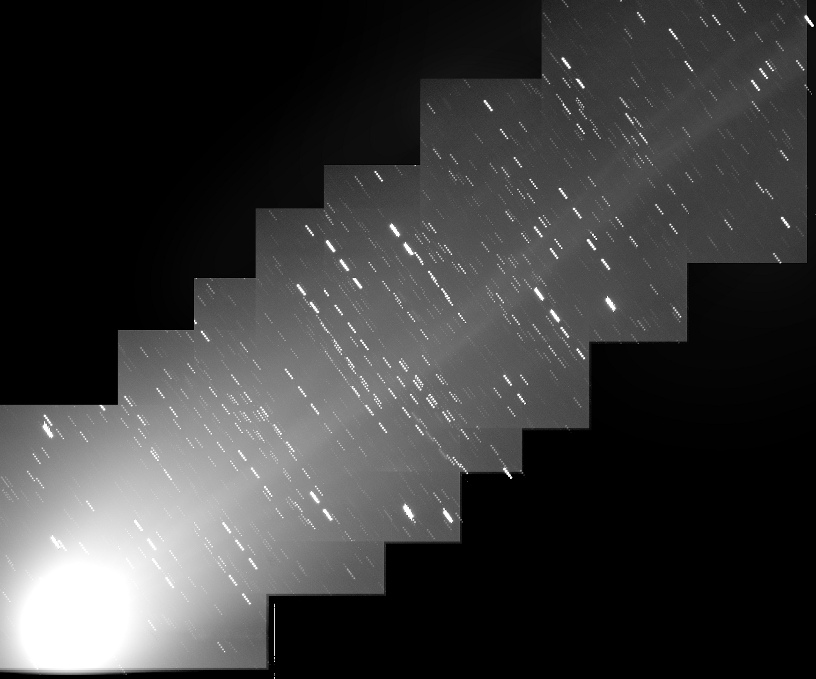
Between 30 Apr. 23:39 UT and May 01, 00:27 UT. This 7-frame mosaic has been made from 35 sub-frames, 5 for each regions. The exposure is 2.5 min. The covered field is about 1.1 degrees along the tail.

30 Apr. 2004, around 23:20 UT. Seven 15-sec images were collected and then median combined to remove the star interference. The resulting frame has been enhanced with unsharp masking to extract the dust shells.
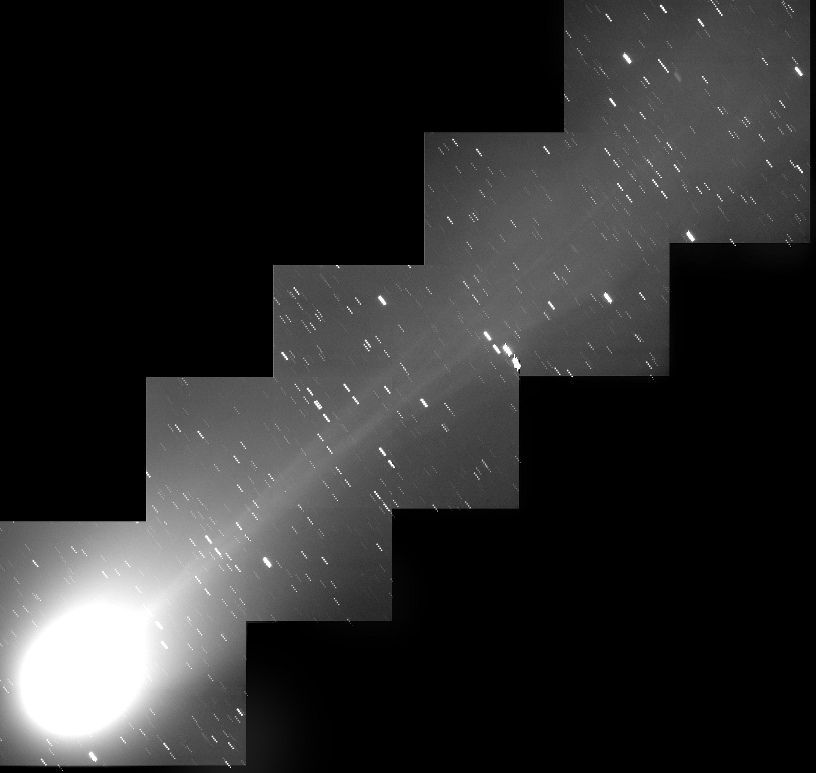
29 Apr 2004, between 23:19 and 23:45 UT. This 5-frame mosaic has been made from 20 sub-frames, 4 for each regions. The exposure is 2 min. The covered field is about 1.2 degrees along the tail.
Between 29 Apr 23:09 UT and 30 Apr. 01:40 UT, 2004. This image shows the dust shells we reported on Apr. 16 (see below). They are obvious after the application of unsharp masking or, as for the image above, rotational gradient. Clicking on the image an animation is available, showing the expansion of the dust waves, as well as changes in the tail. The single frames were obtained median combining 7 images to remove the star interference, being then processed with unsharp masking.
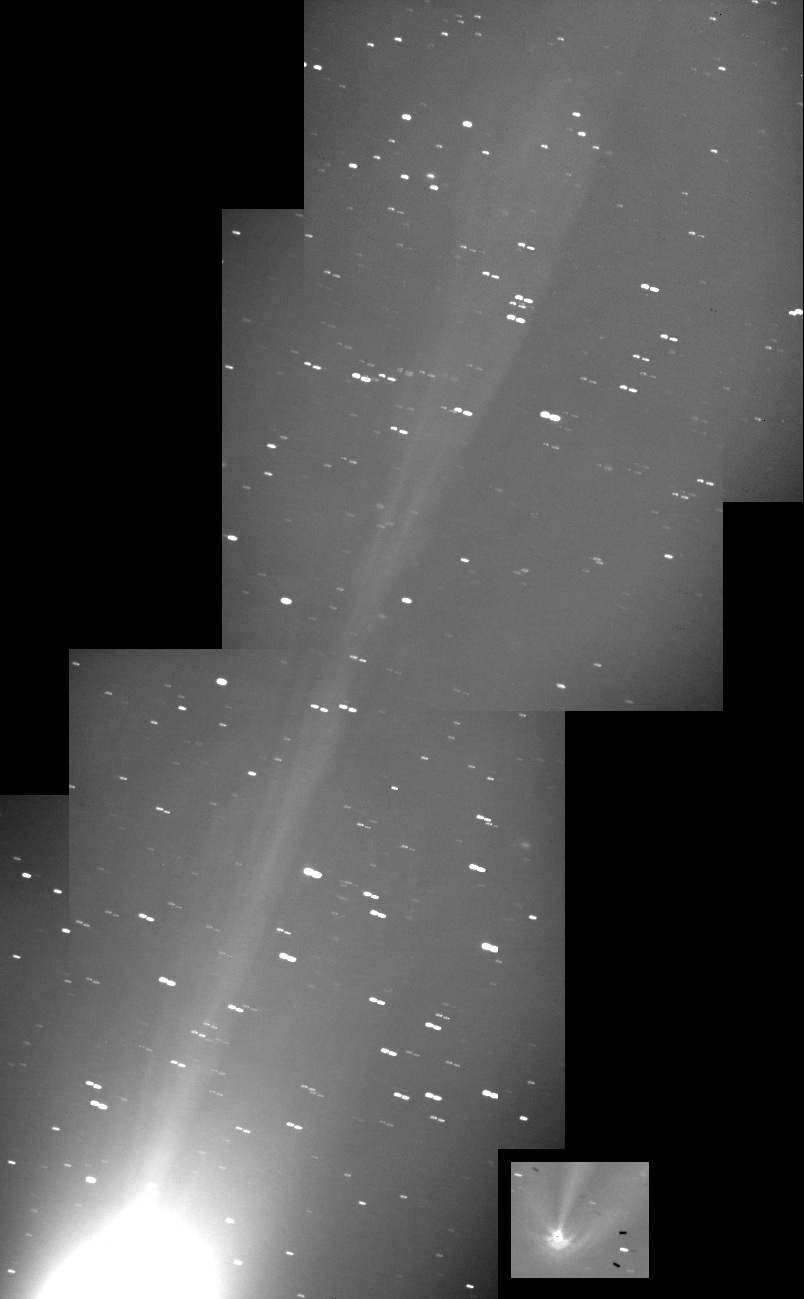
16 Apr. 2004, around 23:55 UT. A set of images were collected to create a mosaic, covering about 0.7 deg. Each area was imaged using a total integration time of 3 minutes. Then the frames have been shifted taking the comet motion into account, in order to keep the higher detail. The tail of the comet is clearly visible; the object was at about 25 deg above the horizon. On the bottom right, the region close to the false nucleus shows clear dust shells.
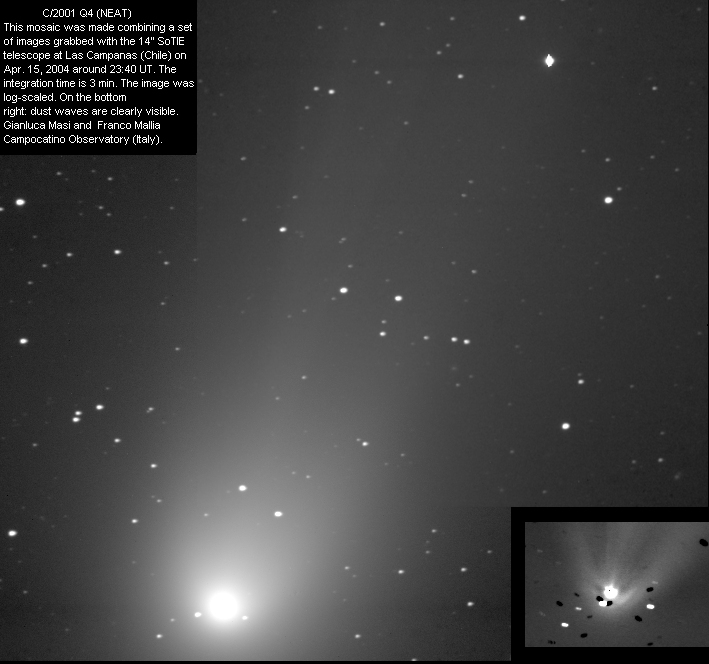
Details on the image.

10 Mar 2004, around 00:15 UT. Six single 60s exposures were added and then DDP-scaled to optimize the visibility of the object. The comet was only about 20 degrees above the horizon and the sky was not completely dark, but we find it quite interesting and showing a very nice tail. SoTIE 14-inch telescope + Paramount GT-1100S + Apogee AP-7P from Las Campanas, Chile. This image has been selected as Image of the day by Space.com

Feb 23, 2004, around 00:30m UT. Eight, 120 seconds images were collected using the SoTIE 14-inch telescope + Paramount GT-1100S + Apogee AP-7P from Las Campanas (Chile). The images were summed avoiding saturation and the resulting frame was log-scaled to optimize the visibility of regions of different brightness.

22 Dec 2003, 01:22 UT. SoTIE 14-inch telescope + Paramount GT-1100S + Apogee AP-7P from Las Campanas, Chile; integration time: 2*1 + 2.5 minutes; Image processing: the three images have been added and then log-scaled (CCDSoft and IRIS); the bright star in the field is SAO 258166. South is up, east on the right.
----------------------------------------
C/2002 T7 was discovered by the LINEAR survey on 12 Oct 2002, when it was quite faint and almost stellar in its shape. When it was still on the Minor Planet Center's NEO Confirmation Page, it was observed by us from Campo Catino (17 Oct. 2002) and the object appeared as slightly diffused. As it was partially involved with a star, we could not firmly conclude if it was a real comet. Follow-up observations showed its real nature. It was clear that this comet had a chance to become an interesting one. Over the months, it was extensively observed (being well-placed in the northern sky), giving a great show. Last spring the comet was really impressive. In April, we spotted it in the morning for the first time (as far as we know) since it left the evening skies.

July 18 2004, 23:45 UT. It was grabbed by Gianluca Masi and Franco Mallia using the SoTIE telescope (C14 + Paramount GT1100S + AP8), located in Las Campanas, Chile. Two-frame mosaic, each one coming from 5 exposures, 60seconds long. Total integration time: 5x60 seconds. The comet shows a clear antitail. South is up, west on the left.

June 14 2004, 23:09 UT. It was grabbed by Gianluca Masi and Franco Mallia using the SoTIE telescope (C14 + Paramount GT1100S + AP8), located in Las Campanas, Chile. Total integration time: 10x30 seconds. The comet shows a clear antitail. South is up, west on the left.
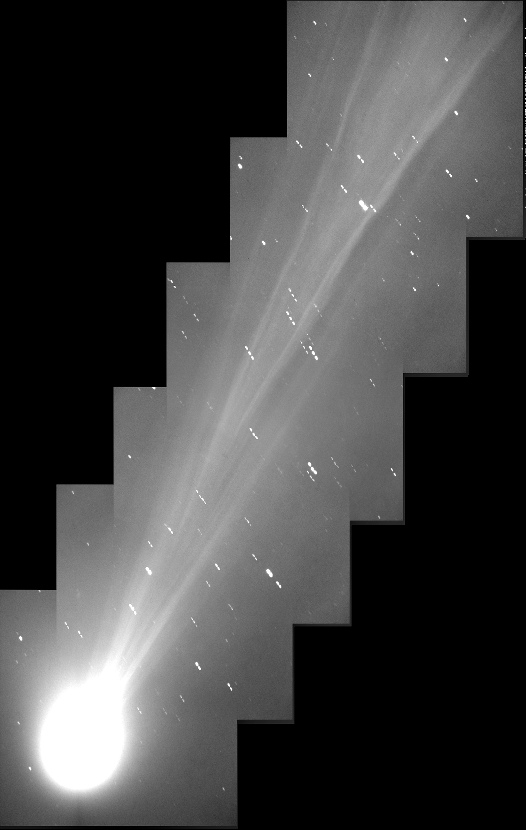
May 5 2004, between 09:19 and 09:59 UT. This stunning image was grabbed using a mosaic technique, in order to cover about 1.15 degrees along the tail. Each part of the mosaic comes from 4 x 30 seconds images, which later have been aligned and properly combined. Then the resulting frame has been DDP-scaled for improved visibility of all the comet regions. A satellite trail is visible. Taken using the 14" SoTIE telescope in Las Campanas (Chile). An higher resolution version of the image is available! Special note: the moon was *full*, but the tail still shows nice deatils.

Apr. 30 2004, between 09:19 and 10:00 UT. This stunning image was grabbed using a mosaic technique, in order to cover about 1.4 degrees along the tail. Each part of the mosaic comes from 4 x 30 seconds images, which later have been aligned and properly combined. Then the resulting frame has been DDP-scaled for improved visibility of all the comet regions. A satellite trail is visible. Taken using the 14" SoTIE telescope in Las Campanas (Chile). An higher resolution version of the image is available!

Apr. 17 2004 at about 09:55 UT. It was taken using the 14" SoTIE telescope in Las Campanas (Chile). It is the first one seen in a while. The comet shows an amazing tail, while an "antitail" is visible as well. This image has been selected as Image of the day by Space.com. Also it appears, with some comments, on BBC news online. A log-scaled version is also available! (this version had been used by Sky & Telescope)